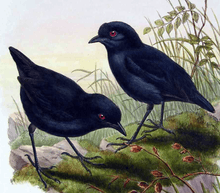Melampitta
| Melampitta | |
|---|---|
 | |
| Lesser melampitta | |
| Scientific classification | |
| Kingdom: | Animalia |
| Phylum: | Chordata |
| Class: | Aves |
| Order: | Passeriformes |
| Family: | Melampittidae |
| Genus: | Melampitta Schlegel, 1871 |
| Species | |
| |
Melampitta is a genus of New Guinean bird containing two enigmatic species. These are birds with black plumage that live in remote rainforests. They are little studied and even their taxonomic relationships with other birds are uncertain.
Taxonomy
The taxonomic placement of the genus is a source of long-standing confusion. The superficial resemblance to the pittas meant that the two species were originally placed within that family. The name of the genus literally means "black pitta". As the structure of the syrinx was that of an oscine bird the genus was later moved to the Old World babblers (an infamous "taxonomic dustbin"), then to Orthonychidae (where some authorities still retain them) and then to the jewel-babblers and whipbirds (the treatment currently used by the Handbook of the Birds of the World).[1] Based on the analysis of DNA-DNA hybridisation data the genus was placed with the Paradisaeidae birds of paradise by Sibley and Ahlquist,[2] although these conclusions are not supported by aspects of the behaviour and biology (although they are possibly related to the recently split Cnemophilidae birds of paradise).[3] More recent studies have suggested a relationship with the Corcoracidae (the white-winged chough and apostlebird of Australia). It recently been suggested that the genus be placed its own family.[1] by most authors and placed here accordingly accept that the both species are congeneric (are both in the same genus), although the two species do have a number of differences, particularly morphologically. The lesser melampitta has three subspecies whereas the greater melampitta is monotypic.
Description
The two melampittas are pitta-like birds that have entirely black plumage and strong long legs.[1] The feathers of the forecrown are erectile. The lesser melampitta is around 18 cm long and weighs around 30 g, whereas the greater melampitta is larger and considerably heavier at around 29 cm in length and weighs 205 g. The bill of the greater melampitta is also larger than that of the lesser melampitta. It also has specially strengthened remiges and retriges, a possible adaptation to its habit of roosting in limestone caves.[4] The sexes in both species are almost identical, with the only sexual dimorphism being a difference in iris colour in the Lesser Melampitta, the male having a red iris and the female a brown one.[3]
Habitat and behaviour
The melampittas are birds of the New Guinean rainforest and are generally montane species as well, with the range of the lesser melampitta reaching as high as 3500 m, with a usual range of around 2000–2800 m.[1] The greater melampitta is restricted to areas of rugged limestone that it apparently roosts and even nests in. Both species have a discontinuous distribution across New Guinea, and the greater melampitta is generally a rare bird that is seldom encountered, although this may because it lives in seldom visited areas. Like most of its supposed relatives the melampittas are insectivores (although in the case of the greater melampitta this is mostly inference). The lesser melampitta feeds on insects as well as worms, snails, small frogs and even small fruit. It forages on the ground, probing through leaves by flipping them with its bill.
Breeding
The breeding behaviour of the melampittas is only known in any detail for the lesser melampitta. All that is known of the breeding of the greater melampitta are reports from local people that it creates nests that are baskets of vines suspended in the limestone sinkholes that it roosts in. The lesser melampitta is known to start nesting in the dry season and continue into the beginning of the wet.[1] The nest is a closed dome shape constructed out of live green moss. The female lays a single chalky white and slightly speckled egg, and undertakes all the incubation duties. The incubation is quite long for a small passerine, lasting around 27 days, during which the male will feed the female.[3] Both sexes feed the single chick, which is hatched covered in downy feathers. Unlike their supposed relatives in the birds of paradise family, which feed their chicks by regurgitation, the parents feed the chick whole food that has not been swallowed. The chick takes up to 35 days to fledge, a long time for passerines.
References
- 1 2 3 4 5 Boles, W. (2007) "Family Eupetidae (Jewel-babblers and allies) "in del Hoyo, J.; Elliot, A. & Christie D. (editors). (2007). Handbook of the Birds of the World. Volume 12: Picathartes to Tits and Chickadees. Lynx Edicions. ISBN 978-84-96553-42-2
- ↑ Sibley, . & Ahlquist, J. (1987). "The Lesser Melampitta is a Bird of Paradise" Emu 87: 66-68
- 1 2 3 Firth, C.B. & D.W. Firth (1990) "Nesting Biology and Relationships of the Lesser Melampitta Melampitta lugubris" Emu 90 (2): 65-73
- ↑ Diamond, J. (1983) "Melampitta gigantea: Possible Relation between Feather Structure and Underground Roosting Habits" Condor 85 (1): 89-91